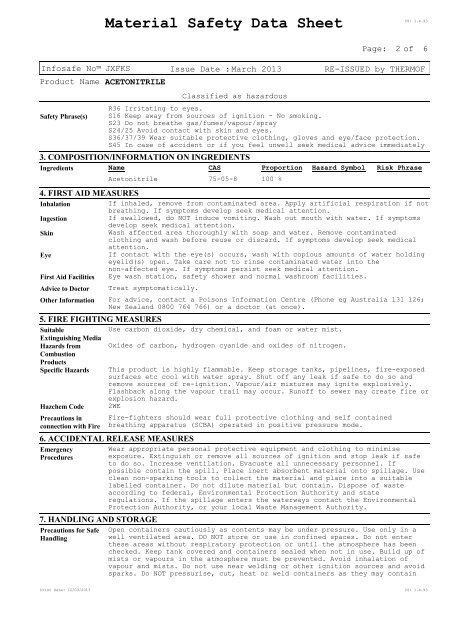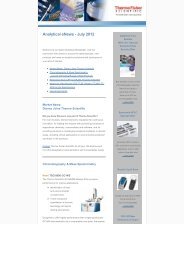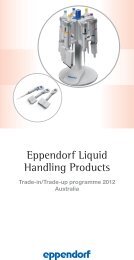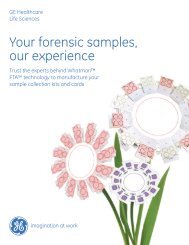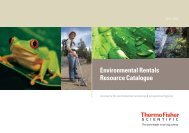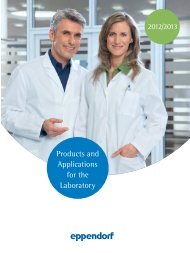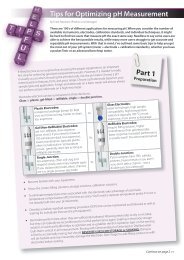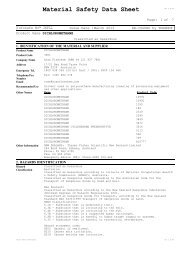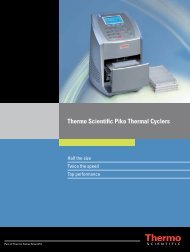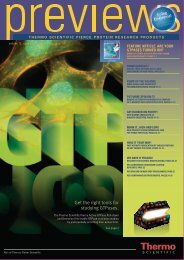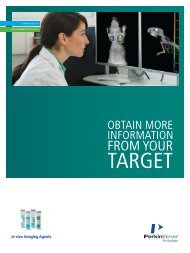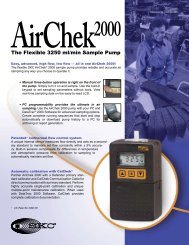View MSDS - Thermo Fisher
View MSDS - Thermo Fisher
View MSDS - Thermo Fisher
Create successful ePaper yourself
Turn your PDF publications into a flip-book with our unique Google optimized e-Paper software.
Material Safety Data Sheet<br />
CS: 1.4.93<br />
Page: 2 of<br />
6<br />
Infosafe No JXFKS Issue Date : March 2013 RE-ISSUED by THERMOF<br />
Product Name ACETONITRILE<br />
Safety Phrase(s)<br />
Classified as hazardous<br />
R36 Irritating to eyes.<br />
S16 Keep away from sources of ignition - No smoking.<br />
S23 Do not breathe gas/fumes/vapour/spray<br />
S24/25 Avoid contact with skin and eyes.<br />
S36/37/39 Wear suitable protective clothing, gloves and eye/face protection.<br />
S45 In case of accident or if you feel unwell seek medical advice immediately<br />
3. COMPOSITION/INFORMATION ON INGREDIENTS<br />
Ingredients<br />
Name<br />
4. FIRST AID MEASURES<br />
Inhalation<br />
Ingestion<br />
Skin<br />
Eye<br />
First Aid Facilities<br />
Advice to Doctor<br />
CAS<br />
Proportion<br />
Acetonitrile 75-05-8 100 %<br />
Hazard Symbol<br />
Risk Phrase<br />
If inhaled, remove from contaminated area. Apply artificial respiration if not<br />
breathing. If symptoms develop seek medical attention.<br />
If swallowed, do NOT induce vomiting. Wash out mouth with water. If symptoms<br />
develop seek medical attention.<br />
Wash affected area thoroughly with soap and water. Remove contaminated<br />
clothing and wash before reuse or discard. If symptoms develop seek medical<br />
attention.<br />
If contact with the eye(s) occurs, wash with copious amounts of water holding<br />
eyelid(s) open. Take care not to rinse contaminated water into the<br />
non-affected eye. If symptoms persist seek medical attention.<br />
Eye wash station, safety shower and normal washroom facilities.<br />
Treat symptomatically.<br />
Other Information For advice, contact a Poisons Information Centre (Phone eg Australia 131 126;<br />
New Zealand 0800 764 766) or a doctor (at once).<br />
5. FIRE FIGHTING MEASURES<br />
Suitable<br />
Extinguishing Media<br />
Hazards from<br />
Combustion<br />
Products<br />
Specific Hazards<br />
Hazchem Code<br />
Precautions in<br />
connection with Fire<br />
Use carbon dioxide, dry chemical, and foam or water mist.<br />
Oxides of carbon, hydrogen cyanide and oxides of nitrogen.<br />
This product is highly flammable. Keep storage tanks, pipelines, fire-exposed<br />
surfaces etc cool with water spray. Shut off any leak if safe to do so and<br />
remove sources of re-ignition. Vapour/air mixtures may ignite explosively.<br />
Flashback along the vapour trail may occur. Runoff to sewer may create fire or<br />
explosion hazard.<br />
2WE<br />
Fire-fighters should wear full protective clothing and self contained<br />
breathing apparatus (SCBA) operated in positive pressure mode.<br />
6. ACCIDENTAL RELEASE MEASURES<br />
Emergency<br />
Procedures<br />
7. HANDLING AND STORAGE<br />
Precautions for Safe<br />
Handling<br />
Wear appropriate personal protective equipment and clothing to minimise<br />
exposure. Extinguish or remove all sources of ignition and stop leak if safe<br />
to do so. Increase ventilation. Evacuate all unnecessary personnel. If<br />
possible contain the spill. Place inert absorbent material onto spillage. Use<br />
clean non-sparking tools to collect the material and place into a suitable<br />
labelled container. Do not dilute material but contain. Dispose of waste<br />
according to federal, Environmental Protection Authority and state<br />
regulations. If the spillage enters the waterways contact the Environmental<br />
Protection Authority, or your local Waste Management Authority.<br />
Open containers cautiously as contents may be under pressure. Use only in a<br />
well ventilated area. DO NOT store or use in confined spaces. Do not enter<br />
these areas without respiratory protection or until the atmosphere has been<br />
checked. Keep tank covered and containers sealed when not in use. Build up of<br />
mists or vapours in the atmosphere must be prevented. Avoid inhalation of<br />
vapour and mists. Do not use near welding or other ignition sources and avoid<br />
sparks. Do NOT pressurise, cut, heat or weld containers as they may contain<br />
Print Date: 12/03/2013 CS: 1.4.93


